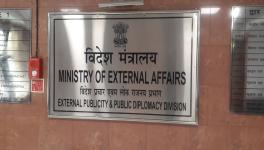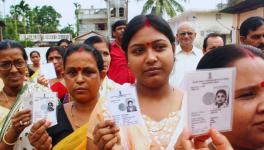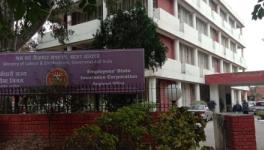MNREGA in Maharashtra: Less Work, More Questions
Image for representational use only; Image Courtesy : livemint
Members of eight organisations working under the MGNREGA scheme from all five regions of Maharashtra met in Nasik in an urgent meeting on January 19 to discuss the most important issue crippling the state currently, i.e. drought. All of them have been complaining about almost zero work on ground under the Mahatma Gandhi National Rural Employment Guarantee Act despite drought like conditions prevailing in the state for a long time. They met to discuss the practical issues as well as immediate solutions.
On February 2, which is the foundation day of MNREGA, these bodies are planning for a 'Kam Mango Abhiyan' (Mission Demand Work) on mass scale in Maharashtra. As the state's rural part is battling the drought, this movement could help it to get work and in turn, relief.
"This year, it is very surprising that the families working under the MNREGA scheme in the state are less than last year. How is this happening in a state which has declared half of the Tehsils under drought? This indicates the number of problems including the government’s failure to deal with the drought as well as migration from rural to urban areas," said Ashwini Kulkarni, member of Pragati Abhiyan, one of the organisations which had given the call for the meeting.
Also Read: How The Modi Government is Killing Off MGNREGS
Interestingly, data available about MNREGA in Maharashtra suggests that the families getting work under the scheme have been more or less the same since 2011-12. In the first year of this decade, around thirteen and half lakh families got work under this scheme. The next year, 2012-13, was also the year of drought where fifteen and half to sixteen lakh families got work. Coming to 2018-19, around sixteen lakh families got work. Now, if you go by just numbers, it would seem that the number of employees under MNREGA has been comparatively similar in this drought year too.
Data Misleading, Government’s Apathy
But the representatives in the Nasik meeting complained about this data being 'misleading'. "This government has brought two schemes under MNREGA. One is the Pradhanmantri Awas Yojana and other is Swachcha Bharat (Toilet) scheme. However, the work of these two schemes when included in the data of MNREG, the larger picture misleads about what is actually happening on the ground," said Vasant Ravangaonkar of Sanskruti Sanvardhan Mandal, Nanded, Marathwada.
The data of Maharashtra government supports his opinion. In 2013-14, rural infrastructure work was little more than one lakh whereas, public work related to National Rural Mission (NRM) was little more than fifty thousand. In 2017-18, public work rose to just 75 thousand whereas, rural infrastructure work increased to more than 2 lakh. Public work under NRM includes lake cleaning, plantation, solid and water conservation, using government land for growing fodder, etc. These works are related with watershed which is helpful in fighting drought. So, by increasing personal work under MNREGA and ignoring public works harms the aim of the scheme.
Also Read: Why Drought-hit Marathwada Farmers Are Demanding Fodder Camps
Currently, MNREGA is a highly recognised and discussed scheme for rural empowerment. But very few know that this scheme was born out of one of the worst ever droughts in Maharashtra in 1972. That time, the then state government came up with the Employment Guarantee Scheme (EGS). This was aimed to provide work to unemployed hands as well as encourage public participation in drought fighting. In 2005, the union government picked up this scheme and relaunched it as MNREGA. However, despite such a background the current participation of the state in the scheme shows a stark reality. "The state administration's apathy to implement MNREGA is the main problem. It is even failing to understand the legacy of the scheme in the state. The actual work in Maharashtra compared to other states are very less," said Subhash Tamboli of Action for Agriculture Renewal in Maharashtra, (AFARM), a federation of different bodies related to agriculture development.
Maharashtra Fares Worse Than Most States
The comparative data of Maharashtra's two adjoining states, Telangana and Karnataka highlights this reality. In Telangana, 40 lakh people have been benefitted under the scheme in 2018-19. In this same ongoing year, Karnataka is providing work to 33 lakh people. In Maharashtra, it is just 27 lakh. This trend of less work has been going on for the last few years. In 2014-15, Karnataka provided work to 30 lakh people, Telangana to 43 lakh and Maharashtra to just 21 lakh.
"If you raise this issue of Maharashtra being pessimistic in implementing the MNREGA, government says that Maharashtra is a rich state and people don't go to work under this scheme. But it is false. Andhra, Tamilnadu, Karnataka and Kerala are richer in rural income than Maharashtra. It means, Maharashtra’s labour needs work under MNREGA," Kulkarni said.
The reasons behind less work under MNREGA are many. The participants in the Nasik meeting complained about the bureaucracy's discouraging response to the labourers’ demands for work. "Rules of work should be given for minimum man days. MNREGA is an act so it has to be followed. But officers mix up the data of personal work with work of water conservation. This allows them to ignore the demand of work. That's why, the MNREGA work is getting delayed. Earlier, by Diwali, labour societies used to demand work and the work used to start coming around January. Now, this time line has been delayed. Labourers demands for work are cleared only after mid-January. This is sad," said Pramod Zinjade, veteran activist from Maharashtra.
Also Read: Another Lifeline Smothered: MGNREGA in Shambles
This ignorance has many repercussions. Labourers are trying to find out options for MNREGA work. This is taking them to cities in search of work. So, the migration from rural areas to semi urban and urban centres of state is also increasing. "MNREGA was started with the aim to stop migration from villages during drought days. People should be empowered for their livelihood through MNREGA in the long term. But if the government’s apathy continues, then migration will also continue," said Tamboli.
Pandurang Patil of Maharashtra Prabodhan Seva Mandal, Nasik said that this migration has decreased the urban wage level too. "Now these migrated labourers from the villages are working in cities on any given pay. This is affecting the wage level in cities too. Urban labour will get poorer due to this. As of now, this has started happening in Nasik itself," he said.
Now, these bodies have decided to chalk out the strategy of further empowering MNREGA as a policy. As an immediate step, forms would be issued to all like-minded bodies for submitting their practical problems. This information will be collected and analysed for more specific targeting of issues. These bodies are also planning to raise a consortium for the representation of their issues. The edited report will be submitted and discussed with state government.
Get the latest reports & analysis with people's perspective on Protests, movements & deep analytical videos, discussions of the current affairs in your Telegram app. Subscribe to NewsClick's Telegram channel & get Real-Time updates on stories, as they get published on our website.
























